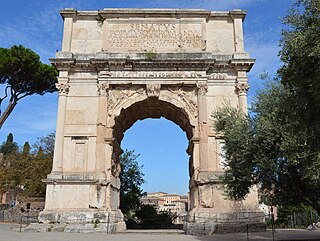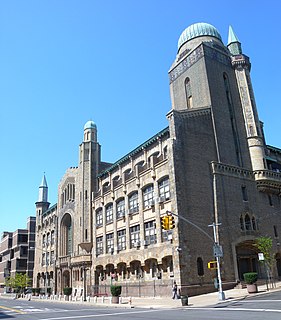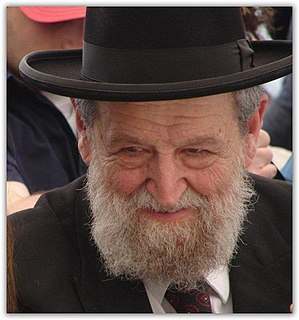A rabbi is a spiritual leader or religious teacher in Judaism. One becomes a rabbi by being ordained by another rabbi – known as semikha – following a course of study of Jewish texts such as the Talmud. The basic form of the rabbi developed in the Pharisaic and Talmudic eras, when learned teachers assembled to codify Judaism's written and oral laws. The title "rabbi" was first used in the first century CE. In more recent centuries, the duties of a rabbi became increasingly influenced by the duties of the Protestant Christian minister, hence the title "pulpit rabbis", and in 19th-century Germany and the United States rabbinic activities including sermons, pastoral counseling, and representing the community to the outside, all increased in importance.

The Arch of Titus is a 1st-century AD honorific arch, located on the Via Sacra, Rome, just to the south-east of the Roman Forum. It was constructed in c. 81 AD by the Emperor Domitian shortly after the death of his older brother Titus to commemorate Titus's official deification or consecratio and the victory of Titus together with their father, Vespasian, over the Jewish rebellion in Judaea. The arch contains panels depicting the triumphal procession celebrated in 71 AD after the Roman victory culminating in the fall of Jerusalem, and provides one of the few contemporary depictions of artifacts of Herod's Temple. It became a symbol of the Jewish diaspora, and the menorah depicted on the arch served as the model for the menorah used as the emblem of the state of Israel.

Antonio Segni was an Italian politician and statesman who served as the president of Italy from May 1962 to December 1964 and the prime minister of Italy in two distinct terms between 1955 and 1960.

Segni is an Italian town and comune located in Lazio. The city is situated on a hilltop in the Lepini Mountains, and overlooks the valley of the Sacco River.

Rabbinic Judaism, also called Rabbinism, Rabbinicism, or Judaism espoused by the Rabbanites, has been the mainstream form of Judaism since the 6th century CE, after the codification of the Babylonian Talmud. Rabbinic Judaism has its roots in Pharisaic Judaism and is based on the belief that Moses at Mount Sinai received both the Written Torah and the Oral Torah from God. The Oral Torah, transmitted orally, explains the Written Torah. At first, it was forbidden to write down the Oral Torah because the rabbis feared that it would become rigid and lose its flexibility, but after the destruction of the Second Temple they decided to write it down in the Talmud and other rabbinic texts.

The Great Synagogue of Rome is the largest synagogue in Rome.
David ha-Levi Segal, also known as the Turei Zahav after the title of his significant halakhic commentary on the Shulchan Aruch, was one of the greatest Polish rabbinical authorities.

Elio Toaff was the Chief Rabbi of Rome from 1951 to 2002. He served as a rabbi in Venice from 1947, and in 1951 became the Chief Rabbi of Rome.

Eugenio Maria Zolli, born Israel Anton Zoller, was an Austrian by birth, and an Italian doctorate professor of philosophy and author. Until his conversion from Judaism to Catholicism in February 1945, Zolli was the chief rabbi in Rome, Italy's Jewish community from 1940 to 1945. After the war, he taught philosophy at a number of institutions throughout Rome including the Sapienza University of Rome and Pontifical Biblical Institute.

The Marsha Stern Talmudical Academy, also known as Yeshiva University High School for Boys (YUHSB), MTA or TMSTA, is an Orthodox Jewish day school and the boys' prep school of Yeshiva University (YU) in the Washington Heights neighborhood in the New York City borough of Manhattan. It is the brother school to the Samuel H. Wang Yeshiva University High School for Girls.
Nicodemus ben Gurion was a wealthy Jewish man who lived in Jerusalem in the 1st century AD. He is believed by some to be identical to the Nicodemus mentioned in the Gospel of John. Elsewhere he is discussed in Josephus' history, The Jewish War, and later, rabbinic works: Lamentations Rabbah, Ecclesiastes Rabbah, the Babylonian Talmud, and Avot of Rabbi Natan.
Riccardo is a male given name, Italian version of Ricardo or Richard. It also may be a surname. It means "Powerful Leader".
Daniel S. ("Danny") Nevins is an American rabbi and a leader in the Conservative Movement who is head of school at Golda Och Academy in West Orange, NJ On January 29, 2007, Rabbi Nevins was named the Dean of the Rabbinical School of the Jewish Theological Seminary of America, succeeding Rabbi William Lebeau. In 2021, it was announced that Rabbi Nevins would be stepping down as dean of the JTS Rabbinical School. He was previously the spiritual leader of Adat Shalom Synagogue in Farmington Hills, Michigan, where he served for 13 years in his first pulpit. He is an authority on Jewish Law who co-authored a responsum that was passed by the Conservative Movement's Committee on Jewish Law and Standards paving the way for the Conservative Movement to allow gay marriage and to ordain lesbian and gay rabbis.

Eliyahu Yosef She'ar Yashuv Cohen was the Ashkenazi Chief Rabbi of Haifa, Israel and the President of its rabbinical courts (1975–2011).
Riccardo Reuven Pacifici was a rabbi from an Italian Jewish family of ancient Sephardic origins, with roots in the Jewish Spanish and rabbinical traditions. Together with his wife, he was murdered in Auschwitz.

'Akbara is an Arab village in the Israeli municipality of Safed, which included in 2010 more than 200 families. It is 2.5 km south of Safed City. The village was rebuilt in 1977, close to the old village destroyed in 1948 during the 1947–1949 Palestine war.
The day of Judaism is an annual day of Christian-Jewish reflection held on January 17 by the Roman Catholic Church in Italy since 1990.
Rubino Romeo Salmonì was an Italian author known for his book In the End, I Beat Hitler, based on his experiences as a survivor of Auschwitz II–Birkenau during the Holocaust.
Lelio Hillel Della Torre (1805–1871) was an Italian Jewish scholar and poet writing in Italian, German, French and Hebrew, best known for his critical translation of the Book of Psalms . He was the son of Solomon Jehiel Raphael ha-Kohen, chief rabbi of Cuneo, Piedmont. His father died in 1807, and Della Torre grew up as an orphan with his mother's family in Casale Monferrato, and after the death of his maternal grandfather in Asti, with his mother's brother, Sabbatai Elhanan Treves. His uncle moved to Torino in 1820, being named chief rabbi of the Jewish communities of Piemont. Della Torre studied Greek, Latin and Italian in Torino, from the age of sixteen working as a private tutor in order to support his mother and three sisters. From 1823, he was teacher for Hebrew philology and biblical exegesis at the Jewish Collegio Colonna e Finzi in Torino. In 1826 he was ordained as rabbi, acting as rabbi of the Torino community from 1827. In 1829, he was called to Padua as professor of Talmud, homiletics and pastoral theology at the newly established rabbinical seminar there, a position he held until his death. He did not serve as rabbi again except for a brief interval in 1869 following the death of the rabbi of Padua. He was married to Anna Bolaffio, with whom he had seven children.










